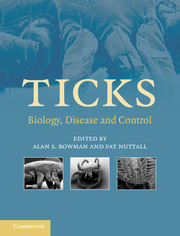Book contents
- Frontmatter
- Contents
- List of contributors
- Preface
- 1 Systematics and evolution of ticks with a list of valid genus and species names
- 2 The impact of tick ecology on pathogen transmission dynamics
- 3 Tick salivary glands: the physiology of tick water balance and their role in pathogen trafficking and transmission
- 4 Tick saliva: from pharmacology and biochemistry to transcriptome analysis and functional genomics
- 5 Tick toxins: perspectives on paralysis and other forms of toxicoses caused by ticks
- 6 Tick lectins and fibrinogen-related proteins
- 7 Endocrinology of tick development and reproduction
- 8 Factors that determine sperm precedence in ticks, spiders and insects: a comparative study
- 9 Tick immunobiology
- 10 Saliva-assisted transmission of tick-borne pathogens
- 11 Lyme borreliosis in Europe and North America
- 12 Viruses transmitted by ticks
- 13 Babesiosis of cattle
- 14 Theileria: life cycle stages associated with the ixodid tick vector
- 15 Characterization of the tick–pathogen–host interface of the tick-borne rickettsia Anaplasma marginale
- 16 Emerging and emergent tick-borne infections
- 17 Analysing and predicting the occurrence of ticks and tick-borne diseases using GIS
- 18 Acaricides for controlling ticks on cattle and the problem of acaricide resistance
- 19 Anti-tick vaccines
- 20 Anti-tick biological control agents: assessment and future perspectives
- 21 Pheromones and other semiochemicals of ticks and their use in tick control
- Index
- References
20 - Anti-tick biological control agents: assessment and future perspectives
Published online by Cambridge University Press: 21 August 2009
- Frontmatter
- Contents
- List of contributors
- Preface
- 1 Systematics and evolution of ticks with a list of valid genus and species names
- 2 The impact of tick ecology on pathogen transmission dynamics
- 3 Tick salivary glands: the physiology of tick water balance and their role in pathogen trafficking and transmission
- 4 Tick saliva: from pharmacology and biochemistry to transcriptome analysis and functional genomics
- 5 Tick toxins: perspectives on paralysis and other forms of toxicoses caused by ticks
- 6 Tick lectins and fibrinogen-related proteins
- 7 Endocrinology of tick development and reproduction
- 8 Factors that determine sperm precedence in ticks, spiders and insects: a comparative study
- 9 Tick immunobiology
- 10 Saliva-assisted transmission of tick-borne pathogens
- 11 Lyme borreliosis in Europe and North America
- 12 Viruses transmitted by ticks
- 13 Babesiosis of cattle
- 14 Theileria: life cycle stages associated with the ixodid tick vector
- 15 Characterization of the tick–pathogen–host interface of the tick-borne rickettsia Anaplasma marginale
- 16 Emerging and emergent tick-borne infections
- 17 Analysing and predicting the occurrence of ticks and tick-borne diseases using GIS
- 18 Acaricides for controlling ticks on cattle and the problem of acaricide resistance
- 19 Anti-tick vaccines
- 20 Anti-tick biological control agents: assessment and future perspectives
- 21 Pheromones and other semiochemicals of ticks and their use in tick control
- Index
- References
Summary
INTRODUCTION
Since the beginning of the twentieth century investigators have documented numerous potential tick biological control agents, including pathogens, parasitoids and predators of ticks (Jenkins, 1964; Mwangi, 1991; Mwangi et al., 1991; Samish & Rehacek, 1999; Kaaya, 2003; Ostfeld et al., 2006). Several authors have reviewed specific groups of natural enemies of ticks, including pathogens (Lipa, 1971; Hoogstraal, 1977; Chandler et al., 2000), nematodes (Samish, Alekseev & Glazer, 2000a, 2000b; Samish & Glazer, 2001), parasitoids (Cole, 1965; Trjapitzin, 1985; Davis, 1986; Mwangi & Kaaya, 1997; Hu, Hyland & Oliver, 1998; Knipling & Steelman, 2000) and predators (Barre et al., 1991; Mwangi, Newson & Kaaya, 1991; Kok & Petney, 1993; Samish & Alexseev, 2001).
In practice, ticks are controlled at present mostly by chemical acaricides (see Chapter 18). However, biological control is becoming an increasingly attractive approach to tick management because of: (1) increasing concerns about environmental safety and human health (e.g. the gradual increase in use of chemical insecticides in several countries is stimulating the growing market of ‘organic’ food); (2) the increasing costs of chemical control; and (3) the increasing resistance of ticks to pesticides. To date, biocontrol has been targeted largely at pests of plants, with only a few efforts to introduce biocontrol agents for the control of ticks. Nevertheless, the knowledge and experience accumulated in plant protection will aid in the development of tick biocontrol methods.
- Type
- Chapter
- Information
- TicksBiology, Disease and Control, pp. 447 - 469Publisher: Cambridge University PressPrint publication year: 2008
References
- 29
- Cited by



